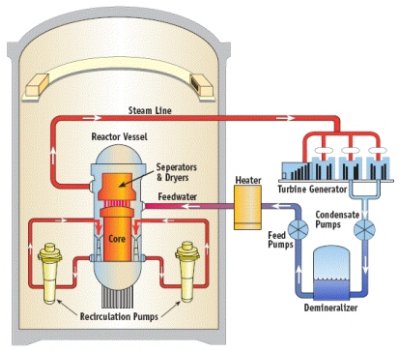Turkey Point Nuclear Generating Station, Florida
Next Update: August 2009
Turkey Point Nuclear Generating Station
Net Generation and Capacity, 2007
Unit |
Net Capacity |
Generation |
Capacity |
Type |
On Line |
License |
| 3 | 693 | 6,708.104 | 100.1 | PWR | Dec. 14, 1972 | Jul. 19 2032 |
| 4 | 693 | 5,148.800 | 84.8 | PWR | Sept. 7, 1973 | Apr. 10, 2033 |
| 1,386 | 11,226.904 | 92.5 | ||||
| *On June 6, 2002, licenses were Renewed. The original license for unit 3 expired in 2012 and for unit 4, in 2013. BWR = Boiling Water Reactor Sources |
||||||
Description: The twin reactors at Turkey Point nuclear station are on a 3,300-acre site near Miami, Florida. The U.S. Nuclear Regulatory Commission (NRC) describes Turkey Point as follows: “Turkey Point, situated on the shores of Biscayne Bay, about 25 miles south of Miami, Florida, is the site for four electric generation units. Units 1 and 2 are fossil-fired and Units 3 and 4 are pressurized light water moderated nuclear units that are owned and operated by the Florida Power and Light Company. The area experiences tropical storms about once every 2 years and hurricane-force winds once every seven years.1
Turkey Point, Unit 3
Nuclear Steam System Supplier (NSSS Vendor)= Westinghouse Electric
Architect Engineer = Bechtel
Owner = Florida Power & Light FPL.
Operator (Licensee) = Florida Power & Light
Turkey Point, Unit 4
Nuclear Steam System Supplier (NSSS Vendor)= Westinghouse Electric
Architect Engineer = Bechtel
Owner = Florida Power & Light FPL.
Operator (Licensee) = Florida Power & Light
Boiling Water Reactor (BWR)
In a typical commercial boiling water reactor (1) the reactor core creates heat, (2) a steam-water mixture is produced when very pure water (reactor coolant) moves upward through the core absorbing heat, (3) the steam-water mixture leaves the top of the core and enters the two stages of moisture separation where water droplets are removed before the steam is allowed to enter the steam line, (4) the steam line directs the steam to the main turbine causing it to turn the turbine generator, which produces electricity. The unused steam is exhausted to the condenser where it is condensed into water. The resulting water is pumped out of the condenser with a series of pumps, reheated, and pumped back to the reactor vessel. The reactor's core contains fuel assemblies which are cooled by water, which is force-circulated by electrically powered pumps. Emergency cooling water is supplied by other pumps which can be powered by onsite diesel generators. Other safety systems, such as the containment cooling system, also need electric power.
 |
| © U.S. Nuclear Regulatory Commission |
Containment: According to the U.S. Nuclear Regulatory Commission, both units include boiling water reactors (BWR) Mark 1 reactors.
_________________________________________
1Effect of Hurricane Andrew on Turkey Point Nuclear Generating Station and Lessons Learned, NRC Information Notice 93-53, U.S. Nuclear Regulatory Commission, July 20, 1993.
Sources for Data in Table: Capacity, for purposes of this report, is the net summer capability as reported in Energy Information Administration (EIA) Form EIA-860, "Annual Electric Generator Report." Capacity Factor is a percentage calculation in which the maximum possible generation (based on net summer capability) is divided into the actual generation then multiplied by 100. Generation is the net electricity output reported by plant owners on Form EIA-906, “Power Plant Report.” Type of Unit: All U.S. commercial reactors currently in operation are one of two types: BWR (boiling water reactor) or PWR (pressurized light water reactor). The type, on-line date, and the license expiration date are published annually in Information Digest by the U.S. Nuclear Regulatory Commission.